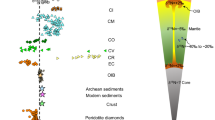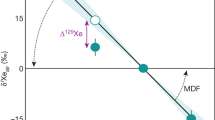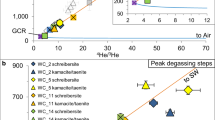Abstract
Identifying the origin of primordial volatiles in the Earth's mantle provides a critical test between models that advocate magma-ocean equilibration with an early massive solar-nebula atmosphere and those that require subduction of volatiles implanted in late accreting material. Here we show that neon isotopes in the convecting mantle, resolved in magmatic CO2 well gases, are consistent with a volatile source related to solar corpuscular irradiation of accreting material. This contrasts with recent results that indicated a solar-nebula origin for neon in mantle plume material, which is thought to be sampling the deep mantle. Neon isotope heterogeneity in different mantle sources suggests that models in which the plume source supplies the convecting mantle with its volatile inventory require revision. Although higher than accepted noble gas concentrations in the convecting mantle may reduce the need for a deep mantle volatile flux, any such flux must be dominated by the neon (and helium) isotopic signature of late accreting material.
This is a preview of subscription content, access via your institution
Access options
Subscribe to this journal
Receive 51 print issues and online access
$199.00 per year
only $3.90 per issue
Buy this article
- Purchase on Springer Link
- Instant access to full article PDF
Prices may be subject to local taxes which are calculated during checkout





Similar content being viewed by others
References
Allègre, C. J., Staudacher, T., Sarda, P. & Kurz, M. Constraints on evolution of Earth's mantle from rare gas systematics. Nature 303, 762–766 (1983)
Porcelli, D. & Ballentine, C. J. Models for the distribution of terrestrial noble gases and evolution of the atmosphere. Rev. Min. Geochem. 47, 411–480 (2002)
Porcelli, D. & Wasserburg, G. J. Mass transfer of helium, neon, argon, and xenon through a steady-state upper mantle. Geochim. Cosmochim. Acta 59, 4921–4937 (1995)
Hart, R., Dymond, J. & Hogan, L. Preferential formation of the atmosphere-sialic crust system from the upper mantle. Nature 278, 156–159 (1979)
O'Nions, R. K. & Oxburgh, E. R. Heat and helium in the Earth. Nature 306, 429–431 (1983)
Davies, G. F. & Richards, M. A. Mantle convection. J. Geol. 100, 151–206 (1992)
Van der Hilst, R. D., Widiyantoro, S. & Engdahl, E. R. Evidence for deep mantle circulation from global tomography. Nature 386, 578–584 (1997)
Van Keken, P. E. & Ballentine, C. J. Dynamical models of mantle volatile evolution and the role of phase transitions and temperature-dependent rheology. J. Geophys. Res. B 104, 7137–7151 (1999)
Kellogg, L. H., Hager, B. H. & Van der Hilst, R. D. Compositional stratification in the deep mantle. Science 283, 1881–1884 (1999)
Becker, T. W., Kellogg, J. B. & O'Connell, R. J. Thermal constraints on the survival of primitive blobs in the lower mantle. Earth Planet. Sci. Lett. 171, 351–365 (1999)
Vidale, J. E., Schubert, G. & Earle, P. S. Unsuccessful initial search for a midmantle chemical boundary with seismic arrays. Geophys. Res. Lett. 28, 859–862 (2001)
Bercovici, D. & Karato, S. Whole-mantle convection and the transition-zone water filter. Nature 425, 39–44 (2003)
Wieler, R. Noble gases in the solar system. Rev. Min. Geochem. 47, 21–70 (2002)
Kallenbach, R. et al. Isotopic composition of solar wind neon measured by CELIAS/MTOF on board SOHO. J. Geophys. Res. A 102, 26895–26904 (1997)
Black, D. C. On the origin of trapped helium, neon, and argon isotopic variations in meteorites — I Gas-rich meteorites, lunar soil and breccia. Geochim. Cosmochim. Acta 36, 347–375 (1972)
Trieloff, M., Kunz, J., Clague, D. A., Harrison, D. & Allègre, C. J. The nature of pristine noble gases in mantle plumes. Science 288, 1036–1038 (2000)
Trieloff, M., Kunz, J. & Allègre, C. J. Noble gas systematics of the Réunion mantle plume source and the origin of primordial noble gases in Earth's mantle. Earth Planet. Sci. Lett. 200, 297–313 (2002)
Ballentine, C. J., Porcelli, D. & Wieler, R. Technical comment on ‘Noble gases in mantle plumes’ by Trieloff et al. (2000) and reply. Science 291, 2269, doi:10.1126/science.291.5512.2269a (2001)
Yokochi, R. & Marty, B. A determination of the neon isotopic composition of the deep mantle. Earth Planet. Sci. Lett. 225, 77–88 (2004)
Sherwood Lollar, B., Ballentine, C. J. & O'Nions, R. K. The fate of mantle-derived carbon in a continental sedimentary basin: Integration of C/He relationships and stable isotope signatures. Geochim. Cosmochim. Acta 61, 2295–2307 (1997)
Ballentine, C. J., Schoell, M., Coleman, D. & Cain, B. A. 300-Myr-old magmatic CO2 in natural gas reservoirs of the west Texas Permian basin. Nature 409, 327–331 (2001)
Broadhead, R. F. Carbon dioxide in northeast New Mexico. West Tex. Geol. Soc. Bull. 32, 5–8 (1993)
Staudacher, T. Upper mantle origin for Harding County well gases. Nature 325, 605–607 (1987)
Phinney, D., Tennyson, J. & Frick, U. Xenon in CO2 well gas revisited. J. Geophys. Res. B 83, 2313–2319 (1978)
Caffee, M. W. et al. Primordial noble gases from Earth's mantle: Identification of a primitive volatile component. Science 285, 2115–2118 (1999)
Ballentine, C. J. & Sherwood Lollar, B. Regional groundwater focusing of nitrogen and noble gases into the Hugoton-Panhandle giant gas field, USA. Geochim. Cosmochim. Acta 66, 2483–2497 (2002)
Moreira, M., Kunz, J. & Allègre, C. J. Rare gas systematics in popping rock: isotopic and elemental compositions in the upper mantle. Science 279, 1178–1181 (1998)
Reid, M. R. & Graham, D. W. Resolving lithospheric and sub-lithospheric contributions to helium isotope variations in basalts from the southwestern US. Earth Planet. Sci. Lett. 144, 213–222 (1996)
Burnard, P., Graham, D. & Turner, G. Vesicle specific noble gas analyses of popping rock: Implications for primordial noble gases in Earth. Science 276, 568–571 (1997)
Marty, B. & Humbert, F. Nitrogen and argon isotopes in oceanic basalts. Earth Planet. Sci. Lett. 152, 101–112 (1997)
Ballentine, C. J. & Burnard, P. G. Production, release and transport of noble gases in the continental crust. Rev. Min. Geochem. 47, 481–538 (2002)
Torgersen, T. & Kennedy, B. M. Air-Xe enrichments in Elk Hills oil field gases: role of water in migration and storage. Earth Planet. Sci. Lett. 167, 239–253 (1999)
Kunz, J., Staudacher, T. & Allègre, C. J. Plutonium-fission xenon found in Earth's mantle. Science 280, 877–880 (1998)
Honda, M. & McDougall, I. Primordial helium and neon in the Earth—a speculation on early degassing. Geophys. Res. Lett. 25, 1951–1954 (1998)
Dixon, E. T., Honda, M., McDougall, I., Campbell, I. H. & Sigurdsson, I. Preservation of near-solar neon isotopic ratios in Icelandic basalts. Earth Planet. Sci. Lett. 180, 309–324 (2000)
Moreira, M., Breddam, K., Curtice, J. & Kurz, M. D. Solar neon in the Icelandic mantle: new evidence for an undegassed lower mantle. Earth Planet. Sci. Lett. 185, 15–23 (2001)
Harrison, D., Burnard, P. & Turner, G. Noble gas behaviour and composition in the mantle: constraints from the Iceland Plume. Earth Planet. Sci. Lett. 171, 199–207 (1999)
Ballentine, C. J., van Keken, P. E., Porcelli, D. & Hauri, E. H. Numerical models, geochemistry and the zero paradox noble-gas mantle. Phil. Trans. R. Soc. Lond. A 360, 2611–2631 (2002)
Saal, E. S., Hauri, E. H., Langmuir, C. H. & Perfit, M. R. Vapour undersaturation in primitive mid-ocean-ridge basalt and the volatile content of Earth's upper mantle. Nature 419, 451–455 (2002)
Marty, B. & Tolstikhin, I. N. CO2 fluxes from mid-ocean ridges, arcs and plumes. Chem. Geol. 145, 233–248 (1998)
Su, Y. & Langmuir, C. H. Global MORB Chemistry Compilation at the Segment Scale (Department of Earth and Environmental Sciences, Columbia University, 2003; available at 〈http://petdb.ldeo.columbia.edu/documentation/morbcompilation/〉.
Wetherill, G. W. in Origin of the Moon (eds Hartmann, W. K., Phillips, R. J. & Taylor, G. J.) 519–555 (Oxford Univ. Press, Oxford, 1986)
Halliday, A. N., Wänke, H., Birck, J. L. & Clayton, R. N. The accretion, composition and early differentiation of Mars. Space Sci. Rev. 96, 1–34 (2001)
Yin, Q. Z. et al. A short timescale for terrestrial planet formation from Hf-W chronometry of meteorites. Nature 418, 949–952 (2002)
Kleine, T., Munker, C., Mezger, K. & Palme, H. Rapid accretion and early core formation on asteroids and the terrestrial planets from Hf-W chronometry. Nature 418, 952–955 (2002)
Porcelli, D., Woolum, D. S. & Cassen, P. Deep Earth rare gases: initial inventories, capture from the solar nebula, and losses during Moon formation. Earth Planet. Sci. Lett. 193, 237–251 (2001)
Porcelli, D. & Halliday, A. N. The core as a possible source of mantle helium. Earth Planet. Sci. Lett. 192, 45–56 (2001)
Tolstikhin, I. & Hofmann, A. W. Early crust on top of the Earth's core. Phys. Earth Planet. Inter. (in the press)
Ballentine, C. J. & O'Nions, R. K. The nature of mantle neon contributions to Vienna Basin hydrocarbon reservoirs. Earth Planet. Sci. Lett. 113, 553–567 (1992)
Ott, U. Noble gases in meteorites—trapped components. Rev. Min. Geochem. 47, 71–100 (2002)
Acknowledgements
Access and permission to sample was by permission of BP (the field is now owned by Oxy) and the Bravo dome field manager, D. Holcomb. Sampling from the West Bush dome was by permission of Amerada Hess. H. Baur provided laboratory support. We thank F. Albarède, D. Porcelli, A. Halliday, A. Hofmann, C. Hall, J. Gilmour, G. Holland, D. Murphy, R. Yokochi and I. Tolstikhin for discussions and critical comments that have improved this Article. This work was funded by the Zurich ETH and NERC.
Author information
Authors and Affiliations
Corresponding author
Ethics declarations
Competing interests
The authors declare that they have no competing financial interests.
Supplementary information
Supplementary Figure 1
A single figure showing the results of a chi-squared minimization, modeling the deviation of the best fit data wedge for a variety of model mantle Ne isotopic values. (PDF 34 kb)
Supplementary Data
Contains detail of the chi-squared test used to test the robustness of the Ne isotope intersect with the MORB-air line. Also contains equations for the planes defined by the data, and details of phase fractionation modelling to assess the limits of this form of fractionation process. Supplementary Figure Legend 1, and Supplementary Table 1 and Supplementary Table 2 are also included. (DOC 112 kb)
Rights and permissions
About this article
Cite this article
Ballentine, C., Marty, B., Sherwood Lollar, B. et al. Neon isotopes constrain convection and volatile origin in the Earth's mantle. Nature 433, 33–38 (2005). https://doi.org/10.1038/nature03182
Received:
Accepted:
Issue Date:
DOI: https://doi.org/10.1038/nature03182
This article is cited by
-
Linking deeply-sourced volatile emissions to plateau growth dynamics in southeastern Tibetan Plateau
Nature Communications (2021)
-
Rapid microbial methanogenesis during CO2 storage in hydrocarbon reservoirs
Nature (2021)
-
Capture of nebular gases during Earth’s accretion is preserved in deep-mantle neon
Nature (2019)
-
Noble gases confirm plume-related mantle degassing beneath Southern Africa
Nature Communications (2019)
-
Geochemical evidence for high volatile fluxes from the mantle at the end of the Archaean
Nature (2019)
Comments
By submitting a comment you agree to abide by our Terms and Community Guidelines. If you find something abusive or that does not comply with our terms or guidelines please flag it as inappropriate.



